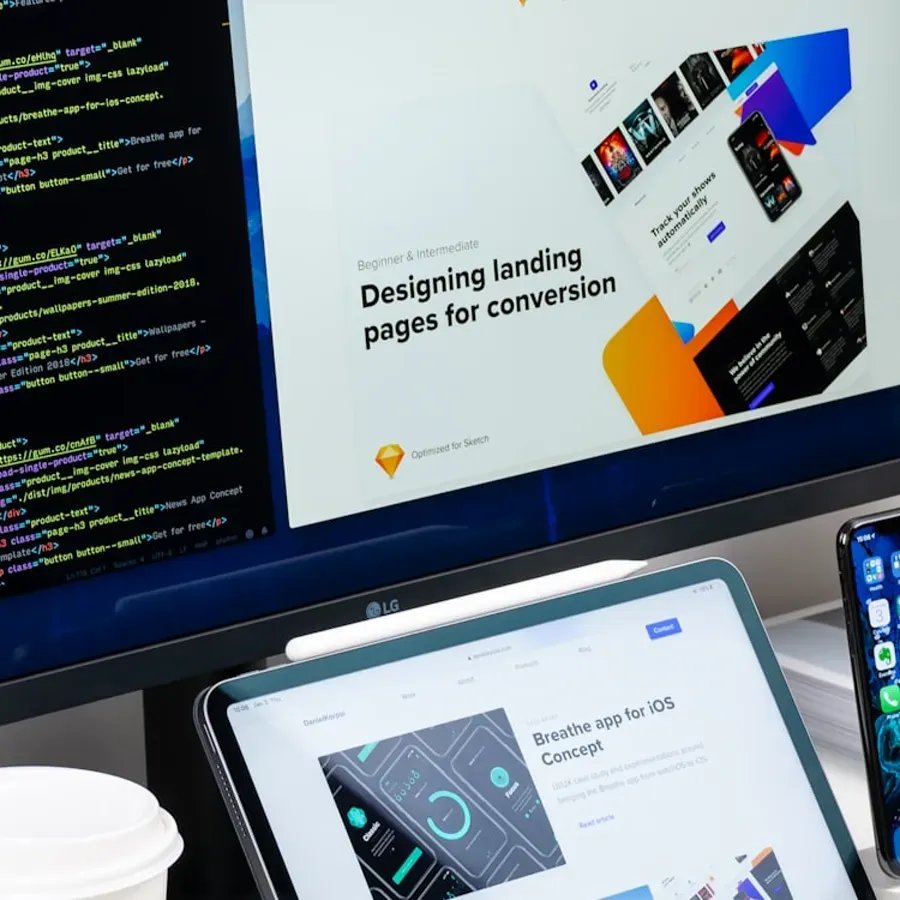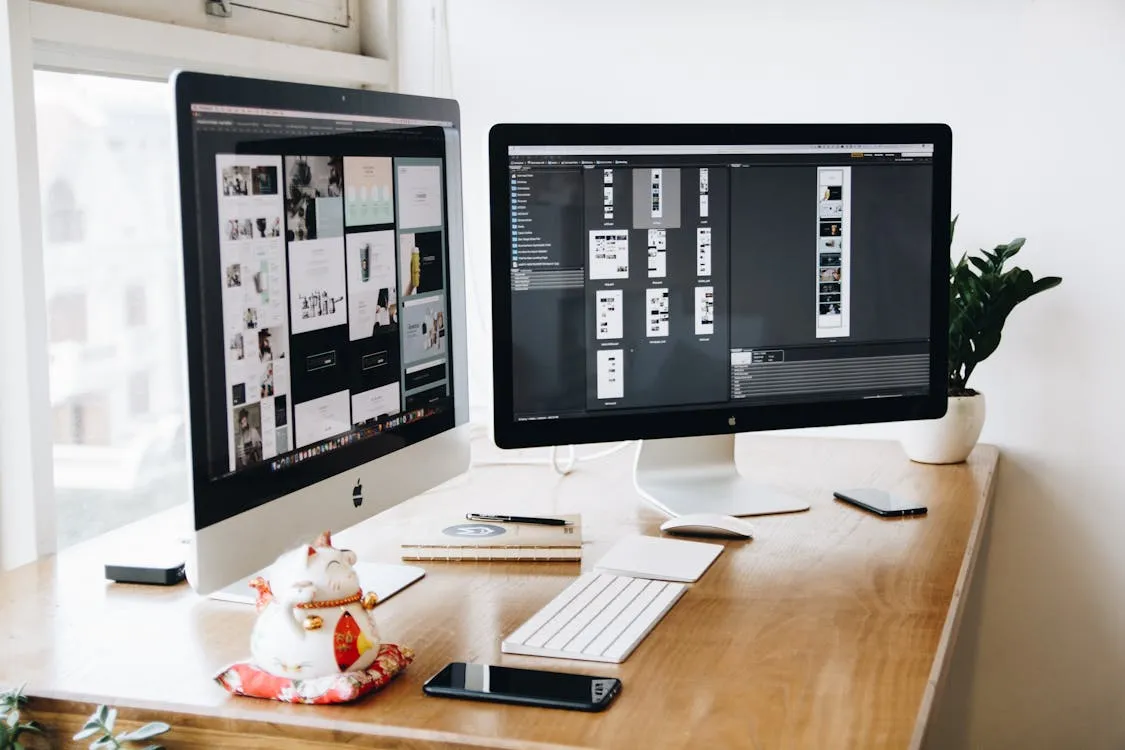
Dark mode is now a baseline expectation across devices. Done well, it reduces eye strain, conserves battery on OLED screens, and gives products a premium feel. Done poorly, it tanks readability, breaks contrast, and adds maintenance debt. This playbook shows how to design, build, test, and ship dark mode at production quality without reinventing the wheel.
1. Principles And Strategy
Treat dark mode as a first-class theme, not a color inversion trick. Define tokens, accessibility gates, and performance budgets up front. Respect user choice: honor system preference via prefers-color-scheme and provide a manual toggle that persists. Keep a single component library that supports both themes through tokens, not duplicate styles.
Decide the tone: cinematic (deep charcoal, soft neon accents) vs. functional (muted surfaces, subtle contrast). Avoid pure black (#000) backgrounds; use near-black (e.g., #0B0B0F to #121212) to reduce haloing and preserve depth.
2. Palette Architecture
Create semantic tokens (surface, elevated surface, border, overlay, backdrop, focus, primary/secondary/neutral text, muted text, disabled, success/warn/error). For each token, define light and dark values. Target contrast: 4.5:1 for body text, 3:1 for UI controls and large text. Ensure focus rings remain visible on all backgrounds.
Layering: use tiered surfaces (base, raised, popover, modal) with slight lightness steps (4–8%) and subtle gradients if needed. Borders should be low-chroma grays—not recycled light theme borders—to avoid visual noise.
State colors: hover/active/focus states need distinct values. Avoid simply darkening already-dark buttons; consider lightening on hover to signal interactivity. For dangerous actions, keep red variants high-contrast without glowing neon.
3. Typography And Legibility
Use crisp antialiasing against dark surfaces. Increase line-height slightly (1.5–1.6) to prevent halation. Prefer type weights that do not appear bolder on dark backgrounds (often 400–500). Keep link styles underlined or visibly distinct beyond color. Avoid low-contrast gray-on-gray microcopy; elevate supporting text to at least 3:1.
4. Imagery, Illustration, And Iconography
Icons: choose strokes/fills that work on both themes; use currentColor or tokenized fills. Provide two-mode assets only when necessary (e.g., logos with dark wordmarks). Avoid drop shadows on dark backgrounds—use subtle inner shadows or light borders instead.
Images: prefer transparent PNG/SVG where possible. For photography, consider slight exposure adjustments or overlays (e.g., a 5–8% black scrim) to avoid blown-out feel. For illustrations, ensure palettes don’t vanish on dark surfaces.
Charts: dark mode requires its own palette—muted backgrounds, distinct series colors with adequate contrast, clear gridlines, and legible axis labels. Validate red/green differentiation for color blindness.
5. Code Implementation With Tokens
Use CSS custom properties for all color and elevation tokens. Set base tokens on :root for light and on [data-theme="dark"] (or .theme-dark) for dark. Flip themes via class on <html> or <body>. Keep component styles color-agnostic by consuming tokens, not hard-coded values.
Example:
:root { --bg: #0b0b0f; --surface: #111116; --text: #f4f5f7; --muted: #b6bbc5; --border: #1f1f27; --focus: #8ab4f8; --primary: #7dd3fc;}[data-theme="light"] { /* optional explicit */ }[data-theme="dark"] { --bg: #0b0b0f; --surface: #121218; --text: #f5f6f7; --muted: #c2c6d0; --border: #20202a; --focus: #8ab4f8; --primary: #7dd3fc;}Apply tokens to layout and components. Keep shadows subtle (rgba(0,0,0,0.35)) and use borders for separation instead of heavy shadows.
6. Prefers-Color-Scheme And Flash Prevention
Detect system preference with @media (prefers-color-scheme: dark). Set an initial class synchronously (inline script in the head) to avoid flash of incorrect theme (FART/FOIT). On the server, render the chosen class when possible. Persist user choice in localStorage and reconcile with system preference on first paint.
Minimal inline script:
(function() { const pref = localStorage.getItem('theme'); const systemDark = window.matchMedia('(prefers-color-scheme: dark)').matches; const theme = pref || (systemDark ? 'dark' : 'light'); document.documentElement.setAttribute('data-theme', theme);})();7. Toggle UX And Persistence
Place the toggle somewhere predictable (header/user menu). Use clear labeling (“Theme” with “Light/Dark” states) and reflect current state with aria-pressed or a radio-group pattern. Persist choice; if user selects “System,” sync to media query changes.
8. Component Patterns
Buttons: ensure background/foreground contrast meets guidelines. Ghost buttons rarely work on dark backgrounds; prefer filled or tonal buttons with clear focus rings.
Inputs/forms: use solid or well-defined borders; avoid translucent fills. Error/success states need text + icon, not just color. Autofill background colors may clash—override browser autofill styles.
Tables: differentiate header, rows, and hover with subtle surface steps and borders. Ensure striped rows meet contrast.
Cards/popovers/tooltips: use elevated surfaces with light borders; include shadow spread that doesn’t blur into the background. Tooltips need solid backgrounds and readable text; avoid translucency.
Toasts: place thoughtfully; ensure focus is not stolen. Provide sufficient dwell time and dismiss controls.
Charts and data viz: ensure gridlines are low-contrast but present; axis labels 4.5:1; interactive points are keyboard and screen-reader accessible.
9. Motion, Depth, And States
Motion reads differently on dark backgrounds. Respect prefers-reduced-motion. Use small, purposeful transitions (opacity/transform at 150–250ms). Avoid aggressive blurs or glows; prefer crisp outlines or subtle highlights. Focus states can use light strokes plus a faint glow to stand off dark surfaces.
10. Performance And Bundling
Minimize theme-switch reflow: keep layout constants and only swap tokens. Avoid loading separate component bundles per theme. For assets, prefer single SVGs with currentColor. If shipping separate hero images, lazy load alternates.
Audit Core Web Vitals after enabling dark mode—extra effects (blurs, shadows) can hurt paint times. Use will-change sparingly.
11. Accessibility Requirements
Contrast: run automated checks (axe/Lighthouse) and manual spot checks. Focus visibility: make focus rings pass 3:1 on all surfaces. Typography: avoid pure white text on pure black to reduce halation. Ensure icons that convey meaning have accessible names. Keep touch targets 44x44px.
Color blindness: pick palettes distinguishable in protanopia/deuteranopia. Validation: never rely on color alone—add text/icons. Captions and alt text remain mandatory for media.
12. Testing Matrix
Devices: desktop (light/dark), mobile iOS/Android (system dark), Windows high-contrast mode. Browsers: Chrome, Safari, Firefox, Edge. Assistive tech: NVDA/VoiceOver with dark backgrounds, keyboard-only traversal. Visual checks: contrast, focus, hover/active states, charts, images, autofill, shadows.
Scenarios: first visit (no preference), toggle switch, system preference change mid-session, login/logout preserving preference, cached pages, offline modes.
13. Migration Plan For Legacy UI
Step 1: introduce tokens and refactor global styles to consume them. Step 2: convert shared components (buttons, inputs, surfaces, cards). Step 3: update page templates (nav, hero, footer, forms). Step 4: audit media assets and illustrations. Step 5: run full a11y + visual regression. Step 6: launch behind a feature flag, gather feedback, then roll out.
14. Content And Branding
Brand colors often need adjustment in dark contexts—lighten or desaturate to avoid glow. Maintain brand recognition via typography, layout, and motion rather than relying solely on brand color saturation.
Copy tone: keep clarity; avoid low-contrast secondary text. Links should remain identifiable. If you use code snippets, ensure syntax highlighting palettes meet contrast.
15. Observability And Metrics
Track: toggle adoption, system vs. manual selections, error rates in dark mode vs. light, contrast audit pass rates, support tickets referencing readability, and Core Web Vitals deltas. Add visual regression snapshots per theme in CI.
16. Security And Third Parties
Test third-party widgets (chat, payments, analytics) in dark mode; many ship light-only styles. Wrap them in containers that enforce background and text colors where possible, or provide fallbacks. Negotiate vendor SLAs for dark mode compatibility.
17. Documentation And Design System
Publish token tables, contrast pairs, component examples in both themes, motion guidance, and implementation snippets (React/Vue/vanilla). Include do/don’t examples: avoid overlaying low-opacity black scrims over already dark media; avoid neon gradients on text; avoid transparent inputs.
Create a “theme starter” code sandbox for engineers and a Figma library with preapproved palettes and elevation steps.
18. QA Checklist (Copy/Paste)
- System preference respected; no theme flash.
- Toggle present, labeled, persists choice, has focus + keyboard.
- Contrast: text 4.5:1, UI controls 3:1, focus rings visible.
- Images/illustrations/icons visible; logos legible.
- Forms: borders, labels, errors visible; autofill styled.
- Components: dialogs trap focus; menus/tabs/accordions follow APG; tooltips readable; carousels pause.
- Charts: axis/labels readable; series distinguishable.
- Motion: honors reduced motion; no flashing.
- Performance: no excessive paint cost; Core Web Vitals stable.
19. Launch Playbook
1) Flag rollout to internal users; gather accessibility feedback. 2) Run full audit (axe/Lighthouse) per key template in both themes. 3) Enable feature flag for a percentage of traffic; monitor metrics. 4) Publish an FAQ and toggle location. 5) Offer feedback channel; prioritize fixes for readability/focus/contrast. 6) Remove flag once stability confirmed.
20. Future-Proofing
WCAG 2.2 places more emphasis on focus visibility and target size; ensure compliance. Watch for future system themes (e.g., “high contrast mode”) and test. Keep tokens centralized so palette changes do not require component rewrites.
Dark mode is ultimately about comfort and clarity. Ship it with rigor so it enhances—not harms—the experience.
21. Detailed Component Guidance
Navigation bars: keep elevation subtle; ensure active states meet contrast; mega menus need keyboard arrow navigation and escape. When sticky, maintain shadow/border to separate from content.
Search: input should have clear border/background; include label; provide inline suggestions with strong contrast and clear highlight for the active item; ensure ESC closes suggestions and focus stays in field.
Lists and cards: provide hover/active states that lighten surfaces; maintain readable spacing; avoid overusing boxed cards—use dividers where density matters.
Modals/side panels: dim backdrops without killing contrast of underlying focus order; trap focus; prevent scroll beneath; ensure close controls are obvious and keyboard accessible.
Maps: consider a dark basemap; ensure pins and labels remain legible; provide a high-contrast outline for selection; watch for vendor tiles that don’t match your theme.
Code blocks: choose syntax themes that keep both text and background at accessible contrast; ensure inline code has padding and contrast; avoid neon highlighting.
Forms at scale: inline validation should announce via aria-live and stay visible against dark fields; tooltips for help must be opaque; disabled controls need text+icon and contrast (not ultra-faint).
22. Handling Media And Assets
Hero images: provide dark-optimized variants or overlays; avoid text-on-image unless tested for contrast in both themes. Video hero sections should default to muted, paused, and offer controls that stand out on dark surfaces.
Icons/logos: prefer single SVG with theme-aware fills/strokes; if two versions exist, swap via currentColor or data-theme selectors. Fallback to text brand if assets fail to load.
23. Patterns For Enterprise And Dashboards
Dense data UIs need stricter hierarchy: use surface steps, strong text contrast, and clear gridlines. Provide in-panel filters instead of floating pills that disappear. For status chips, combine color, text, and icon; ensure focus states on all controls in tables (buttons, menus, toggles).
Notifications: toasts and inline banners should avoid neon backdrops—use tonal surfaces with clear text. Keep stacking sensible; ensure screen readers announce via polite/ assertive live regions based on severity.
24. Expanded Testing Scripts
Create scripted runs: (a) first visit from clean profile, (b) toggle to light and back, (c) switch OS theme while page is open, (d) keyboard through nav, forms, modals, carousels, charts, (e) screen reader pass for key templates, (f) mobile tests in system dark, (g) high-contrast mode (Windows) to ensure no hidden dependencies.
25. Migration Anti-Patterns To Avoid
- Duplicating stylesheets instead of tokenizing (creates drift).
- Inverting colors via filters (breaks contrast and brand).
- Theme-specific component forks (increases bugs).
- Leaving vendor iframes untreated (stark white rectangles).
- Ignoring print styles (ensure print is legible regardless of theme).
26. Documentation To Ship
Publish: token map, contrast matrix, approved palettes, component gallery in both themes, example pages (marketing, app, forms, data), motion guidelines, toggle patterns, SSR/FOUC mitigation snippet, QA checklist, troubleshooting tips, and links to design files/code sandboxes.
Keep docs close to code; update when tokens change to prevent stale guidance.
27. Metrics And Feedback Loops
Instrument toggle usage; segment errors and conversions by theme; track most-viewed pages in dark mode and prioritize polish there. Capture qualitative feedback via in-app surveys targeted to dark-mode users. Review monthly and feed back into design system updates.
28. Resilience And Edge Cases
Offline pages, error states, empty states, and loading skeletons must also be themed. Ensure skeletons aren’t low-contrast gray on charcoal. Captcha/identity flows often come from vendors—test and wrap them. Emails: provide light-safe versions; many clients ignore dark CSS, so avoid white text on transparent backgrounds in email templates.
29. Education And Rollout
Train teams on how to use tokens, how to test, and how to file theme bugs. Add lint rules for disallowed colors. During rollout, create a known issues list and communicate mitigations. Celebrate the release with examples of improved readability and comfort.
With these patterns, you can launch dark mode that feels intentional, branded, and accessible—worthy of becoming the default for users who prefer it.
30. Extended QA And Troubleshooting
Common issues: text too dim (raise contrast), focus lost after modal close (restore to trigger), hover states invisible (brighten surfaces), autofill yellow clashing (override autofill styles), vendor iframe blinding (wrap in container or request dark theme), charts with invisible gridlines (lighten grid/labels).
Regression watch: new components skipping tokens, one-off colors added, unthemed plugins, screenshots/figures with white backgrounds, print styles broken by dark overrides.
Check after perf tuning: removing shadows/borders that hurt delineation; replacing them with borders or subtle overlays.
31. Governance And Ownership
Assign a theme owner in the design system. Add a theme checklist to pull requests. Run monthly token drift reports (detect hard-coded colors). Include dark-mode coverage in visual regression tests. Maintain a “known gaps” log with dates and owners.
32. Business Storytelling
Report on readability improvements, reduction in support tickets about glare, user adoption of dark mode, and performance parity. Share customer quotes. Use these to justify ongoing investment in tokens, audits, and vendor compliance.
Dark mode is a craft. With solid tokens, disciplined patterns, and continuous testing, it becomes an asset—not a novelty.
33. Mini Quick-Start For New Teams
1) Set WCAG AA and token strategy on day one. 2) Pick light/dark palettes with contrast baked in; document in Figma. 3) Implement tokens in CSS variables and add a head script to avoid flash. 4) Build core components (buttons, inputs, nav, modals, cards) against tokens. 5) Wire toggle with persistence and “System” option. 6) Run axe/Lighthouse + keyboard + screen reader checks on key flows. 7) Roll out behind a flag, monitor, iterate.
Repeat per feature: design with tokens, build semantically, test in both themes, ship with confidence.
Keep dark mode governed by tokens, tested every sprint, and measured in production. When users can read comfortably at midnight or in sunlight without eye strain, you know you built it right.
Dark mode should feel effortless—no squinting, no glare, no lost focus. Ship it with care, and it becomes a brand strength users seek out.
34. Mobile And Battery Considerations
OLED benefits: darker pixels save power, but only if backgrounds are truly dark and large flat areas avoid mid-gray. Keep large surfaces near #0b0b0f–#16161c. Test battery impact on iOS/Android with profiling tools. Ensure touch states are visible outdoors—bright focus/active outlines help under sunlight.
Gestures: provide keyboard/tap alternatives; swipe-only carousels must also respond to buttons. On mobile Safari, avoid oversized blurs that increase paint cost. For PWA installs, set theme-color meta tags for dark/light so browser UI matches the page.
35. Framework Tips
React/Vue: set theme on <html data-theme>; use context/store for toggle; hydrate with server-side class to avoid mismatch. Next/Nuxt: inject theme script in <Head>/_document to prevent flash; avoid rendering until preference known if you must. Tailwind: use class-based dark mode; define custom tokens in config; add prose customizations for markdown. Design tokens: export to CSS vars + JSON to keep Figma/Code in sync.
Native bridges: if wrapping in React Native/WebView, ensure in-app browsers respect user setting and pass theme to web content.
Dark mode is a systems problem: tokens, tooling, processes, audits, and culture. Solve it once in your design system, keep it tested, and every feature inherits a premium, comfortable experience.
36. SEO, Analytics, And Compliance
Ensure structured data and meta tags are theme-agnostic; schema markup must remain readable in both themes. Set Open Graph/Twitter images that work on light and dark backgrounds. In analytics, segment by theme to see if dark-mode users convert differently. If operating in regulated markets, include dark-mode checks in compliance reports and VPAT/ACR updates.
37. Support And Feedback Ops
Update support scripts so agents can help users find and use the toggle. Add a quick “Looks too dark/too bright?” option in your feedback widget pointing to contrast tips or to the theme toggle. Track these submissions to spot problem areas (e.g., specific templates or third-party embeds).
As you scale locales, validate fonts, glyph support, and cultural color cues. Dark palettes can read as premium in some markets and somber in others; user testing across regions keeps tone aligned to brand.




